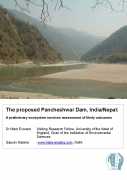 This report by the IES presents the findings of a study that explores the likely impacts of the recent proposals in India to build a dam at Pancheshwar in the Himalayas on the river ecosystems and the surrounding areas and people involved. This dam will be the world's second tallest structure intended to harness hydroelectric power and water by controlling the flow of the Kali river and its tributaries.
This report by the IES presents the findings of a study that explores the likely impacts of the recent proposals in India to build a dam at Pancheshwar in the Himalayas on the river ecosystems and the surrounding areas and people involved. This dam will be the world's second tallest structure intended to harness hydroelectric power and water by controlling the flow of the Kali river and its tributaries.
The document argues that although there are many benefits of the dam in terms of energy and water, the wider ramifications of the dam and its consequences for the people staying around the area have not been thought about in the planning process. The planning process has not engaged local people in the decision-making process, there is paucity of published information and the environmental and social consequences have been considered belatedly in the planning process.
The study concludes that the negative environmental consequences of the proposed Pancheshwar Dam would be substantial and long-lasting, and would affect people and ecosystems over a wide geographical scale. The dam construction would threaten not only high-priority nature conservation areas and the general river ecosystem downstream, but also the livelihoods of many people, both local and across the catchment, by degrading the ecosystem of the river.
The document argues that this lack of consideration for the negative impacts of the dams, the marginalisation of the stakeholders in the process of decisionmaking and the top to down decisionmaking process involved, indicates a serious failure of the democratic process.
This emphasis on economic gains by using big technology solutions without consideration of the social, economic and cultural consequences for the people and environment concerned indicates a lack of sensitivity of the government to basic human rights and environmental concerns.
The document calls for a need to seriously reassess the proposed scheme in the light of the limitations of the scheme to address serious human rights violations and crucial environmental concerns.
Download the report: